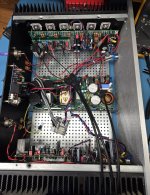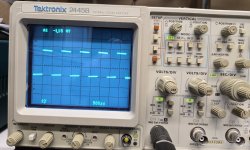Touching the lid changes something. The best guess is RF. Ground the lid and try setting bias doing the same things you did before.
That droop isn't too bad. Why not feed it a sine and decrease frequency until it begins to drop? That is a more realistic test. Input coupling caps can do this as well.
Anyway, I would have to have a similar amplifier and feed it the same signal to tell you if it was normal or not.
Anyway, I would have to have a similar amplifier and feed it the same signal to tell you if it was normal or not.
1)What is frequency that you tested?I am back to working on the bad IPS board. I fed it a 100mVpp square wave and got the output shown below. I'm getting downward sloping trapazoids instead of square waves. Any hints as to what that means? I tested both working channels with square waves and got nice square waves
View attachment 1430921
2)Use d.c not a.c coupling.
I am interested in this amp. I am a beginner at amp building, and recently put together the ACA Mini. Is this build something that I can probably handle?
Yes, the build guide is great and there are a number of people who will help if you run into issues. Just be sure to read it once before starting, then check off as you go.
Great news! I forgot to ask this in my last post but, I am not sure which version I should make...the EF-3 or EF-4. I realize that is the number of transitors, but not sure how the final product differs in terms of output and sound.
I'm not disagreeing with RickRay at all... but only you can really assess if it's something you can handle (or want to take on).I am interested in this amp. I am a beginner at amp building, and recently put together the ACA Mini. Is this build something that I can probably handle?
The ACA Mini is about the easiest project I've ever built. It's designed to be easy. You really (I mean unless you really, really tried) can't blow it up / damage parts or hurt yourself. How'd that build go for you? No issues... went together in a snap and worked perfectly?
The Wolverine is a COMPLETELY different animal, pun intended.
You're dealing with mains voltages, careful wiring is needed, a lot more parts are required, there is a much higher parts density, and even some of your own DIY "parts making" i.e. inductor winding may be needed. It's a major leap in skills required to successfully get a Wolverine working properly, IMO.
The build guide is exceptional; no question. However, even with an exceptional build guide, it trips up even experienced builders. Are you ready to troubleshoot / de-solder / repair etc, should something go wrong?
Only you know if you can take it on comfortably. As Rickray suggested, read the build guide. I'd suggest reading it about 3 times. THEN decide if you want to take it on now... or later. THEN you'll also know which variant you may want to tackle first based on your power requirements (or wants) and the challenge and expense of the build.

@ItsAllInMyHead Actually I did have one issue with my mini...I got distracted and put a MOSFET in the wrong spot, had to de-solder and find a replacement. But yes all in all it was very easy for me. I build a wooden enclosure, wired up an a different led power button, as well as rca, speaker, and DC power plugs. I really love that little amp, I just raised the bias a bit and absolutely love how it sounds with my tube preamp. But I just want more power 🙂
Any advice on which version to build?
Any advice on which version to build?
^ Sweet!
Version... that's a tough one. My advice is to take a look at the kick butt spreadsheet one of the folks put together. I can't look it up right now, or I'd just attach it for you. It walks through a phenomenal path from the "speakers backward" to help determine rail voltages / power etc. based on even the dynamic range of the music you listen to etc. etc. It's amazing.
Perhaps someone has super easy access and can attach it quickly for you in a post.
Version... that's a tough one. My advice is to take a look at the kick butt spreadsheet one of the folks put together. I can't look it up right now, or I'd just attach it for you. It walks through a phenomenal path from the "speakers backward" to help determine rail voltages / power etc. based on even the dynamic range of the music you listen to etc. etc. It's amazing.
Perhaps someone has super easy access and can attach it quickly for you in a post.
- Home
- Amplifiers
- Solid State
- DIY Class A/B Amp The "Wolverine" build thread


